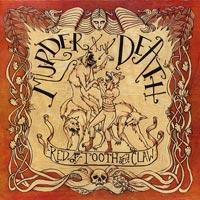
Murder by Death
Red of Tooth and Claw (2008)
Darren
It's hard to argue with Murder By Death's track record. The band's debut full-length, Like the Exorcist, But More Breakdancing was a solid introduction and perhaps the most experimental of the band's releases. 2003's Who Will Survive, And What Will Be Left of Them? not only avoided the sophomore slump, but also saw the band really finding its voice, deeply rooted in dark narratives and a western influence. The band built on that success with 2006's In Bocca al Lupo, an eclectic collection of songs that drew inspiration from Dante's Inferno to create a moody concept album focused on sin and punishment. Needless to say, this strong history has created high expectations for for the band's latest release, Red of Tooth and Claw. So, just how does the album stack up to it's predecessors?
Within the opening seconds of the disc's opening track, "Comin' Home," the first thing that becomes apparent is that Murder By Death's singer Adam Turla somehow sounds even more similar to Johnny Cash than he did on In Bocca al Lupo. Turla's baritone drawl carries the track, with repetition of the title creating a skeleton that the band works around. Once again, the band shines musically, with the rhythm section providing a wonderful backbone while Sarah Balliet's cello once again offers beautiful melodies that often steal the spotlight.
Another highlight of every Murder by Death release is the lyrical content, and while Red of Tooth and Claw falls slightly short of tradition, it still holds its own. Due to the album's motif of repetition of lines, the poetry can occasionally be disappointingly simple, but when Turla is free to be a storyteller, he's still among the best in the game. The album's nomadic narrator is constantly on the move, struggling to appease his many vices: "The heat floats on top of our skin / Like an ice cube in a glass of gin / ⦠/ Baby, it's been so long / that even the roses hips are turning me on."
One problem that becomes apparent, though, is that while the band had successfully evolved their sound over the previous three full-lengths, this one seems to have been painted-by-numbers, so to speak. Most tracks feel as though they would fit comfortably on In Bocca al Lupo, and while that may delight some fans, most probably wanted to see what surprises this talented group could come up with. Furthermore, a lot of tracks seem slightly uninspired at their outset; "Ash," for example, is fairly ordinary until about halfway through, at which point the song finally gets off the ground and delivers.
Though the disc becomes stagnant far too often, when it is at its strongest, it has some of the best moments that the band has to offer. In particular, the album's closer, "Spring Break" is a chilling track that features a perfect buildup to a triumphant conclusion. The previously disillusioned narrator finally makes a last-ditch effort at creating a new life for himself, without realizing the inherent contradiction in forging a new life that hardly differs from the fashion he has conducted himself through the album's entirety.
There are many drawbacks to creating great records. You may attract the wrong kind of audience, you may become fodder for rumor-filled music blogs or you may just face a greater pressure from your record label to stick to a successful formula. But perhaps the most common downside to creating a lauded album is that the next disc you release is going to be examined with far more scrutiny than it otherwise would. Murder By Death's Red of Tooth and Claw falls victim to this trap, and despite being a fairly solid disc in its own right, simply cannot stand up next to the band's back catalogue.